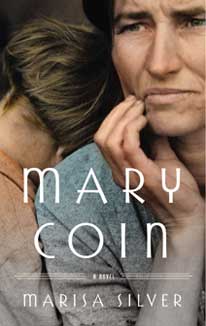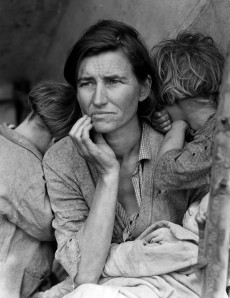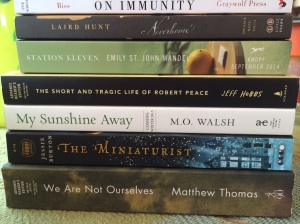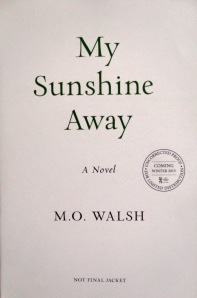I hadn’t heard of the book Mary Coin or the author Marisa Silver. I met someone who works for one of the big publishers. I told her what books I like, including a recent read — The Orchardist by Amanda Coplin — a quiet book about quiet lives in a remote part of Washington state. Mary Coin, a quiet, skillfully written book, takes us to California by way of Oklahoma.
The book alternates between the lives of three different people. First, we follow Walker, a present day middle-aged academic, who is sort of a socio-historian. He goes to small towns and puts together individual histories by combing through attics, old ledgers, photo albums, old local newspapers, etc. He has neglected his own family and, recently divorced, is now dealing with his teenaged children and his dying father.
The other two stories take place mostly in the 1920’s and 1930’s. One follows title character, Mary Coin, who grows up in a one-room sod house in a small town in Oklahoma. Insects live in the dirt walls of the house and Mary feels “as trapped as that cricket, stuck in this house filled with the sweet smell of rotting earth.” She marries young and she and her husband end up in California looking for work in the forests and fields.
The third story follows Vera Dare, whose life is based on that of real-life photographer Dorothea Lange. She lives in San Francisco where she has a photography studio specializing in debutantes and high- society portraits. The Great Depression takes Vera out of her studio — she is hired by the Farm Security Administration to photograph the poor, particularly farm workers.
Walker talks about his work and the difference between looking and seeing: “This unimportant image or piece of information that no one cares about? Well, there is a story here, too, and I’m going to find out what it is.” Seeing is not just a glance. It is looking past surfaces and using one’s imagination.
That is exactly what Marisa Silver is doing in this book. Silver’s jumping off point is Lange’s 1936 photograph, Migrant Mother. Silver has gone past looking and is reimagining the lives of ordinary people. We see the characters through life and death and through love and loss. We see the loneliness and hardships of their lives, whether poor or privileged.

A lesser known photo of Florence Owens Thompson and four of her seven children
The role of photography is an underlying theme throughout the book. In an interview, Silver said that Migrant Mother “became an inadvertent icon and made its way down through the generations in all sorts of forms – as an exhibit in museums, as a document in textbooks, even as a U.S. postage stamp. The life of the original object was interpreted and reinterpreted, and, as a piece of history, it adopted meanings and values that were different from those in play at the moment of its making.” The real subject of the photograph, Florence Owens Thompson, did not reveal her identity until late in her life when she was very ill and needed money for health care.
The book allows us to contemplate how photographs capture a single moment and how we relate to that moment. It also allows to think about how photography has changed. Silver says, “Photography is an interesting form because it is one that is practiced not only by artists, but by everyone. We are a planet of image-makers. Instamatic… instagram, the message is that life can be captured and fixed in an instant.” Walker, the character, wonders what will happen now that digital photography means there will “be no dusty albums hidden in attics for someone like him to discover.” It is an unanswered question “but every age deserves its fashion and its forms, and no one can control what survives.”
Each of the three strands of the story was interesting on its own. It was a beautiful read. I wanted to know more about the characters and I was driven by the mystery of how their lives would intersect.
Buy this book at Amazon
Buy this book at Powell’s
The Big Buzz: Keep an Eye Out for These Books
Book Expo of America (BEA) is the largest book trade show in the U.S. This year’s show was last week at Javits Center in New York. The main event is the Exhibit Hall where publishers are marketing next season’s books to booksellers, librarians and the media. There are also a number of panels–including the Editor’s Buzz Panel. This year’s panel: 7 editors from 7 publishing companies, each one championing one book, in hopes of bringing it out from under the radar. Six of the seven books are scheduled to be published in late August or September. One of the books won’t be published until 2015. Five of the books were fiction, two non-fiction.

Station Eleven by Emily St. John Mandel
Jennifer Jackson, Senior Editor, Alfred A. Knopf with Emily St. John Mandel’s Station Eleven
SYNOPSIS: This book is about a traveling Shakespearean theater company in a post-apocalyptic world. It starts on a night right before a fever epidemic changes the world. A famous actor dies onstage during a performance of King Lear. The story moves back and forth between the actor’s life and a time 15 or 20 years after the epidemic. (This reminds me of the recent play Mr. Burns by Anne Washburn which also had a traveling theater troupe in the years after most of the world’s population has died). In looking at the survivors’ lives after an apocalyptic change, the book is, Ms. Jackson said, “an elegy to the world as we know it.”
INTERESTING TIDBIT: Ms. Jackson explained that this book had a backwards route to publication. Emily St. John Mandel has three previous novels all from a small indie publisher. Instead of agent to editor to sales force to booksellers, here it was the booksellers who became fans of Mandel’s work and talked her up to the sales rep. The sales rep told Ms. Jackson about the author.
COMPARISONS: Cloud Atlas (David Mitchell), Dog Stars (Peter Heller), A Visit from the Goon Squad (Jennifer Egan)
PUBLICATION DATE: September 9, 2014
MY TAKE: I like stories that move back and forth between two time periods. A comparison to Cloud Atlas intrigues me. I’ve read a couple of pre-apocalyptic novels lately (Age of Miracles and The Last Policeman), and am watching a couple of post-apocalyptic shows on TV, so I might enjoy the contrast. But, I’m not sure about this one. . .

We Are Not Ourselves by Matthew Thomas
Marysue Rucci, Vice President and Editor-in-Chief, Simon & Schuster
with Matthew Thomas’ WE ARE NOT OURSELVES
SYNOPSIS: Eileen Leary, a nurse from Queens, NY is working to build a nest egg to move her Irish American family to Westchester. But things do not always go as planned. This hefty novel follows the nurse and her family through three generations. It is about hope and resilience in the face of disappointment. It is about the American middle class in the 20th century.
INTERESTING TIDBIT: This is the author’s first novel. Thomas spent 10 years writing on the book while working as an English teacher.
COMPARISONS: Olive Kitteridge (Elizabeth Strout), Charming Billy (Alice McDermott)
BLURBS: Joshua Ferris, Charles Bock and Chad Harbach
PUBLICATION DATE: September 2, 2014
MY TAKE: I definitely want to read this one. In addition to the Book Buzz Panel, it was recommended to me by people who have had a chance to read the advance copy. It sounds like it has the combination of good writing and good plot that I will enjoy.

The Miniaturist by Jessie Burton
Lee Boudreaux, Vice President, Editorial Director, Ecco with Jessie Burton’s THE MINIATURIST
SYNOPSIS: Set in 17th century Amsterdam, a young wife is given a dollhouse by her husband to keep her occupied while he is busy working as a merchant trader. She orders a set of miniature furniture from an artisan. After receiving her order, she begins to receive additional miniature items that she didn’t order. What message is the artisan trying to send her. The suspenseful story is about secrets and hypocrisy, appearance vs. truth.
INTERESTING TIDBIT: The editor, Boudreaux, also recommended Lauren Oliver’s adult debut, Rooms (coming in September), and Smith Henderson’s recently published Fourth of July Creek.
COMPARISONS: Fingersmith (Sarah Waters), Slammerkin (Emma Donoghoe), The Signature of All Things (Elizabeth Gilbert)
BLURB: SJ Watson (Before I Go to Sleep)
PUBLICATION DATE: August 26, 2014
MY TAKE: Not sure about this one. I am interested in the background of Amsterdam during the height of the East India Dutch Company, and the exploration of the position of women in society at the time. The Amsterdam setting and the bird on the cover (though green, not gold) are meant to invoke the book Goldfinch which I really liked. Also, I am a fan of Fingersmith which this book was compared to. My only concern is that there may be a “supernatural” element which I am not sure I would enjoy.
Amy Einhorn, Vice President and Publisher, Amy Einhorn Books/Putnam with M.O. Walsh’s MY SUNSHINE AWAY
SYNOPSIS: The debut novel takes places in Baton Rouge, Louisiana, where the author M.O. Walsh lives. It starts out “there were four suspects in the rape of Lindy Simpson” and later in the first chapter: “I should tell you now that I was one of the suspects.” Einhorn insisted that this is not a book about rape. It is about adolescence, family, memory and forgiveness.
BLURBS: By Tom Franklin (Poachers) and Kathrynn Stockett (The Help)
COMPARISONS: Master storytellers of the south such as Harper Lee, Flannery O’Connor and Kathrynn Stockett
PUBLICATION DATE: January 15, 2015
MY TAKE: This sounds like a good one–a page turner with something more than a mystery. I also like the idea of a first person narrator, the question of whether the narrator is reliable and a story that reveals itself slowly–all of which this book sounds like it has.

Neverhome by Laird Hunt
Josh Kendall, Executive Editor, Little, Brown and Company with Laird Hunt’s NEVERHOME
SYNOPSIS: The novel starts out “I was strong and he was not, so it was me went to war to defend the Republic.” This is a civil war story about a woman who takes her husband’s place on the battlefield. Why does she do this? Will she come home?
INTERESTING TIDBIT: The author grew up on a farm in southern Indiana. The novel is based on letters he found in the barn.
BLURBS: Paul Auster, Kevin Powers
COMPARISONS: Cold Mountain (Charles Frazier), Winter’s Bone (Daniel Woodrell)
PUBLICATION DATE: September 9, 2014
MY TAKE: If editor Kendall didn’t sell me on this book, I’m more likely to read it because of Paul Auster’s blurb: “A spare, beautiful novel . . . had me under [its] spell from the first word of Neverhome to the last. Magnificent.”

On Immunity by Eula Biss
Jeffrey Shotts, Executive Editor, Graywolf Press
with Eula Biss’ ON IMMUNITY: AN INOCULATION
SYNOPSIS: An investigation of the fears and myths surrounding the subject of vaccinations. Diseases that were irradiated are now resurfacing as a result of people who have stopped vaccinating their children. Editor Shotts explained that it is mainly college educated white, upper middle class people who have the greatest fears about inoculation. The book brings in Patton, Defoe, Candide, Dracula, Dr. Bob and many more references into the discussion.
INTERESTING TIDBIT: (1) The author, a winner of the National Book Critics Circle Award for criticism, grew interested in the when she became a mother and was dealing with her own fears. (2) The editor’s name is Shotts.
COMPARISONS: Susan Sontag (On Photography), Barbara Ehrenreich (Nickel and Dimed), Andrew Solomon (Far From the Tree)
PUBLICATION DATE: September 30, 2014
MY TAKE: This is a very timely subject. Jon Stewart even had a whole piece on it last night featuring Samantha Bee. I find the subject very interesting, but am not sure I will get around to this one.

The Short and Tragic Life of Robert Peace by Jeff Hobbs
Colin Harrison, Editor-in-Chief, Scribner with
Jeff Hobbs’ THE SHORT AND TRAGIC LIFE OF ROBERT PEACE: A BRILLIANT YOUNG MAN WHO LEFT NEWARK FOR THE IVY LEAGUE
SYNOPSIS: Robert Peace was charismatic, smart, well-liked and a Yale University graduate with a degree in microbiology. He was also an African American who died at the age of 30 as the result of a drug-related murder. Colin Harrison described this book as overwhelming and claustrophobic. One that hits the reader at a primal level. It races questions about poverty, race and education.
INTERESTING TIDBIT: The author of the book was Robert Peace’s roommate at Yale for 2 years.
COMPARISONS: Random Family
PUBLICATION DATE: September 23, 2014
MY TAKE: I am putting this on my TBR list, though I can tell I will find the book sad and frustrating.
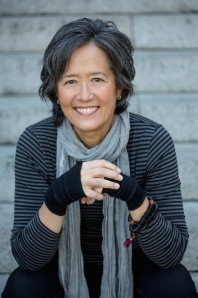 A Tale for the Time Being
A Tale for the Time Being is Ruth Ozeki’s third novel, after My Year of Meats
and All Over Creation
. It was short-listed for the 2013 Man Booker Prize and won the Los Angeles Times Book Prize for Fiction.
The main character is also named Ruth Ozeki and her life bears a lot of resemblance to that of the author. Ruth, the character, lives on a small island off the Pacific Northwest coast of Canada, where she finds a plastic bag containing a diary of a Japanese teenage girl washed up on the beach. The novel alternates between a narrative of Ruth’s life, as she reads the diary and tries to find out what happened to the girl, and the first person narrative of the diary itself.
Within this framework Ozeki plays some games with time. The diary is written in a notebook that had been has been made by replacing the pages of Proust’s book “In Search For Lost Time” with blank pages. In a Guardian newspaper interview, Ozeki said “I think that all writing is in search of lost time.”
The girl calls herself a “time being”. In fact, the girl’s name is Nao—pronounced “now”. The girl is addressing the diary to a reader—putting them in the same time zone—the present. But, what Ruth is reading is history and for the girl, her reader is someone in the future. The girl may not even be alive—did she die in the 2011 Japanese earthquake and tsunami? Did the girl kill herself, as she indicates she may do in certain passages?
 Nao’s story is quite harsh. She is the victim of brutal bullying from other students. Teachers seem to be complicit and her parents oblivious. Nao moves away from school and home into a world of Japanese culture that seems quite bizarre—from cafes where the waitresses are dressd as French maids ready and willing to indulge their customers fantasies and fetishes to the life of Nao’s great-grandmother who lives in relative isolation as a buddhist nun and in which Nao encounters the supernatural.
Nao’s story is quite harsh. She is the victim of brutal bullying from other students. Teachers seem to be complicit and her parents oblivious. Nao moves away from school and home into a world of Japanese culture that seems quite bizarre—from cafes where the waitresses are dressd as French maids ready and willing to indulge their customers fantasies and fetishes to the life of Nao’s great-grandmother who lives in relative isolation as a buddhist nun and in which Nao encounters the supernatural.
Ozeki’s characters are dealing with displacement and disconnection. Ruth, the character, like Ozeki, has moved from New York to British Columbia to be with her husband, but after years there, she still doesn’t feel at home. She and her husband are not always able to communicate well. Nao has spent much of her childhood in northern California and has only recently returned to her country of birth. She was never fully American and now is being taunted as an outsider within Japan.
The novel explores suicide—through Nao’s father, who tries unsuccessfully to kill himself, through Nao who contemplates it, and through Nao’s great-uncle who was a kamikaze pilot in World War II. There are also explorations into technology—as we see how the internet affects both Nao’s story and Ruth’s investigation into what happened to Nao. We learn about enviromental issues, quantum physics and garbage floating on the oceans gyres. In a Bookslut blog interview, Ozeki has said “the whole idea of a time being is a being that has a limited amount of time . . . So this negotiation around how much time we have . . . and the way we live our lives as a result of the way we think about it — these are very important things in the book. And so it does make sense to me that there are so many characters contemplating the end of their life in one way or another.”
At the end of the book, Ruth is having trouble finding traces of Nao and her family on the internet. Also, she has seen items on the internet that seem to have disappeared. It turns out that someone in the book may removing specific personal histories from the internet—particularly useful when the history is embarrassing or the includes the result of humiliating pranks of bullies. I thought of this part of the book when reading about the EU’s recent ruling that people can have links removed from Google.
There was some lovely writing and some interesting juxtapositions and expositions in “A Tale for the Time Being.” But the themes were sometimes too disparate. At times, particularly when the story verged on the surreal, I had to struggle to make it to the end.
“What’s the point of solving murders if we’re all going to die?”
That is the tagline for the book The Last Policeman: A Novel by Ben Winters.
It looks like a giant meteor will hit earth and do some serious damage within the year, but Detective Hank Palace is going to work every day and he’s trying to solve the latest murder. Well, first he has to prove it’s a murder and not one of the now commonplace suicides.
He’s only been in the police force for a little more than a year—he moved up the ranks quickly due to the high attrition – everyone is leaving their jobs in order to spend their last months at the beach.
Winters has imagined what would happen if everyone was told they had less than a year to live. Hoarding and abandonment of the production lines leads to shortages of basic needs and services. U2’s “Until the End of the World,” Tom Waits’ “Earth Died Screaming,” “and of course that R.E.M. song” (“It’s the End of the World As We Know It”) are having a comeback. People’s relationships and priorities are changing. The description of these consequences was my favorite part of the book and reminded me of the distopian novel The Age of Miracles: A Novel in which author Karen Thompson Walker imagined a world where the the earth’s rotation was slowing down and days were getting longer and longer.
Though it sounds like a sci-fi novel, The Last Policeman reads stylistical more like an old fashioned noir—it clocks in at just 288 pages and is told in first person. It starts out with Detective Palace standing over the dead body. Things seem a little not quite right, but at first we don’t know why. What is happening reveals itself slowly—so we feel a little like detectives in reading the book and putting the facts together.
I really wanted to love this book—it is a murder mystery with some indie creds that give it a cool factor and it even won the 2013 Edgar Award for Best Paperback Original. But, while I enjoyed the pre-apocalyptic setting, the narrator and a number of the characters we met along the way, there were some plot features that didn’t work. The murder mystery itself was a bit of a letdown and there were some confusing side-plots involving Hank’s sister that didn’t make sense.
The Last Policeman is the first of a trilogy. The second book, Countdown City: The Last Policeman Book II (Last Policeman Trilogy), is already available and the third book, World of Trouble: The Last Policeman Book III
,
is due in July of this year. Though I didn’t love the book, I am intrigued enough to continue on with the series.
